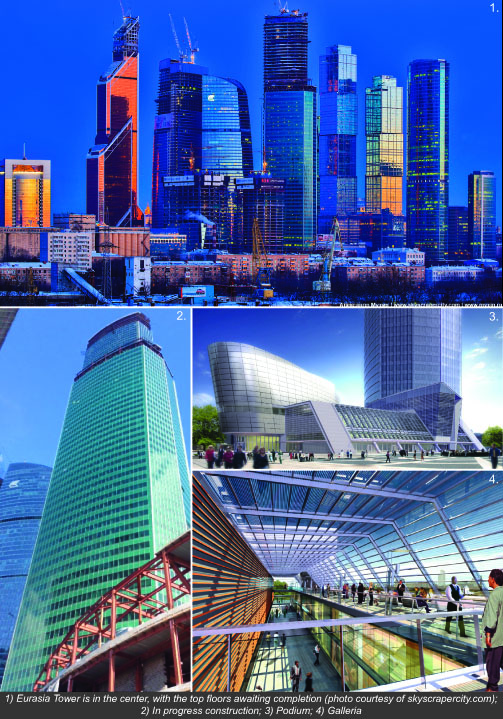This year’s completion of the 2.2 million-sf Eurasia Tower, designed by Swanke Hayden Connell Architects (Swanke), represents the successful culmination of a decade-long immersion in the development of “New Russia,” and expands the firm’s international architectural expertise to include high-rise, mixed-use design.
The 72-story tower—the first mixed-use, steel tower in Russia—is located within the new, 30 million-sf, 148-acre Moscow International Business Center (MIBC) or “Moscow City.”
The complex and the tower are based on futuristic development standards of a world class financial center and intermodal hub. Using the best of the 21st century's innovative technologies, the center intends to rival those of New York City and London and be one of the most desirable locations in Russia and Europe. It was recently designated the fourth tallest skyscraper in Europe by Emporis, the international provider of building data.
The Eurasia Tower is the second Swanke-designed building rated by Emporis, which also rated the Is Bankasi Towers Complex among the top-ten innovative and imposing designs of notable bank buildings around the world. The Is Bankasi design brought Swanke to the attention of Summa, a Turkish international contractor/developer working for Russian investors, and led to the Eurasia Tower commission in 2007.
Eurasia Tower is 1,013 feet high. Within it are 50 floors of Class A office space and 20 floors of luxury residential apartments with their own gymnasium and pool on the 50th floor. The tower sits on a retail and entertainment podium that includes boutiques, restaurants, bars, a 149-room hotel, and parking.
As one of the more refined towers in the MIBC complex and the third tallest, the architectural skin of the building reinforces the purity of the tower volume over the complexity of the program within. The unitized curtain wall allows the transition from the office floors of fixed windows to operable windows on the residential floors. The overall architectural form is developed as a pure glass, curving, curtain wall tower with its broad faces versus its tripartite ends sitting on a multi-volume podium.
The success of Eurasia Tower led directly to Swanke's re-commission last year to design a tower complex, Project Silver, in Moscow. It will be a 1,437-unit, upmarket, residential complex with three 52-story towers, on a two-story, above-grade, mixed-use podium of residential amenities, office, retail, and parking. Much attention is being given to seamlessly integrate this 3.2 million-square foot complex into the surrounding neighborhood adjacent to a public park.
Related Stories
| Aug 11, 2010
Citizenship building in Texas targets LEED Silver
The Department of Homeland Security's new U.S. Citizenship and Immigration Services facility in Irving, Texas, was designed by 4240 Architecture and developed by JDL Castle Corporation. The focal point of the two-story, 56,000-sf building is the double-height, glass-walled Ceremony Room where new citizens take the oath.
| Aug 11, 2010
Carpenters' union helping build its own headquarters
The New England Regional Council of Carpenters headquarters in Dorchester, Mass., is taking shape within a 1940s industrial building. The Building Team of ADD Inc., RDK Engineers, Suffolk Construction, and the carpenters' Joint Apprenticeship Training Committee, is giving the old facility a modern makeover by converting the existing two-story structure into a three-story, 75,000-sf, LEED-certif...
| Aug 11, 2010
Utah research facility reflects Native American architecture
A $130 million research facility is being built at University of Utah's Salt Lake City campus. The James L. Sorenson Molecular Biotechnology Building—a USTAR Innovation Center—is being designed by the Atlanta office of Lord Aeck & Sargent, in association with Salt-Lake City-based Architectural Nexus.
| Aug 11, 2010
San Bernardino health center doubles in size
Temecula, Calif.-based EDGE was awarded the contract for California State University San Bernardino's health center renovation and expansion. The two-phase, $4 million project was designed by RSK Associates, San Francisco, and includes an 11,000-sf, tilt-up concrete expansion—which doubles the size of the facility—and site and infrastructure work.
| Aug 11, 2010
Goettsch Partners wins design competition for Soochow Securities HQ in China
Chicago-based Goettsch Partners has been selected to design the Soochow Securities Headquarters, the new office and stock exchange building for Soochow Securities Co. Ltd. The 21-story, 441,300-sf project includes 344,400 sf of office space, an 86,100-sf stock exchange, classrooms, and underground parking.
| Aug 11, 2010
New hospital expands Idaho healthcare options
Ascension Group Architects, Arlington, Texas, is designing a $150 million replacement hospital for Portneuf Medical Center in Pocatello, Idaho. An existing facility will be renovated as part of the project. The new six-story, 320-000-sf complex will house 187 beds, along with an intensive care unit, a cardiovascular care unit, pediatrics, psychiatry, surgical suites, rehabilitation clinic, and ...
| Aug 11, 2010
Colonnade fixes setback problem in Brooklyn condo project
The New York firm Scarano Architects was brought in by the developers of Olive Park condominiums in the Williamsburg section of Brooklyn to bring the facility up to code after frame out was completed. The architects designed colonnades along the building's perimeter to create the 15-foot setback required by the New York City Planning Commission.
| Aug 11, 2010
Wisconsin becomes the first state to require BIM on public projects
As of July 1, the Wisconsin Division of State Facilities will require all state projects with a total budget of $5 million or more and all new construction with a budget of $2.5 million or more to have their designs begin with a Building Information Model. The new guidelines and standards require A/E services in a design-bid-build project delivery format to use BIM and 3D software from initial ...
| Aug 11, 2010
Opening night close for Kent State performing arts center
The curtain opens on the Tuscarawas Performing Arts Center at Kent State University in early 2010, giving the New Philadelphia, Ohio, school a 1,100-seat multipurpose theater. The team of Legat & Kingscott of Columbus, Ohio, and Schorr Architects of Dublin, Ohio, designed the 50,000-sf facility with a curving metal and glass façade to create a sense of movement and activity.








